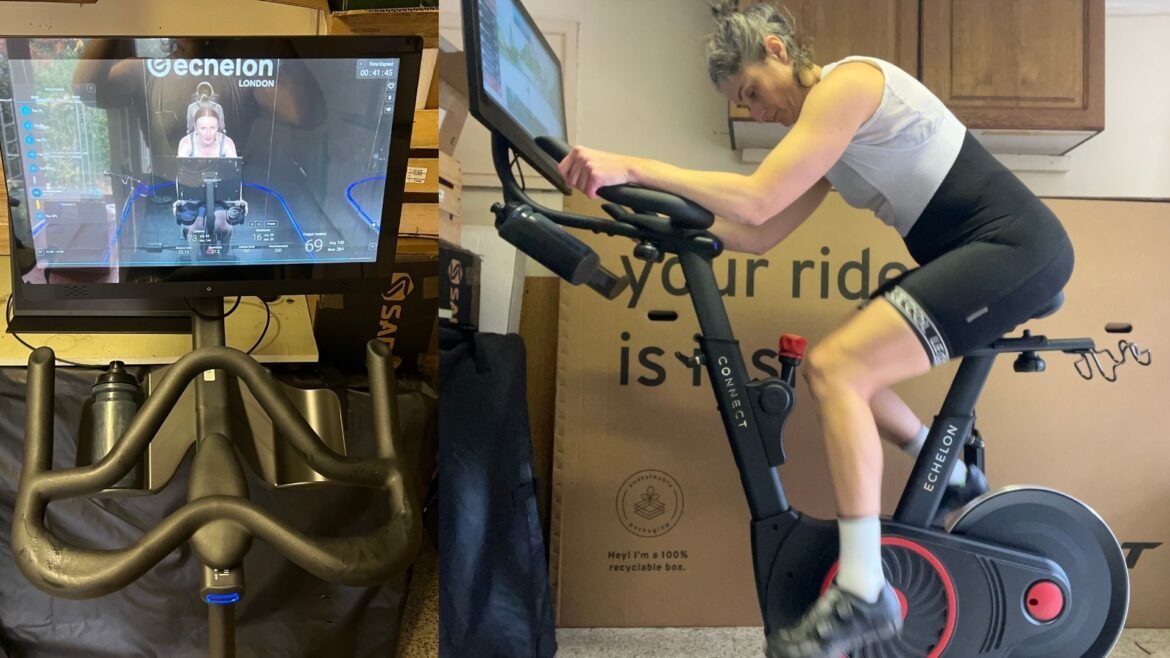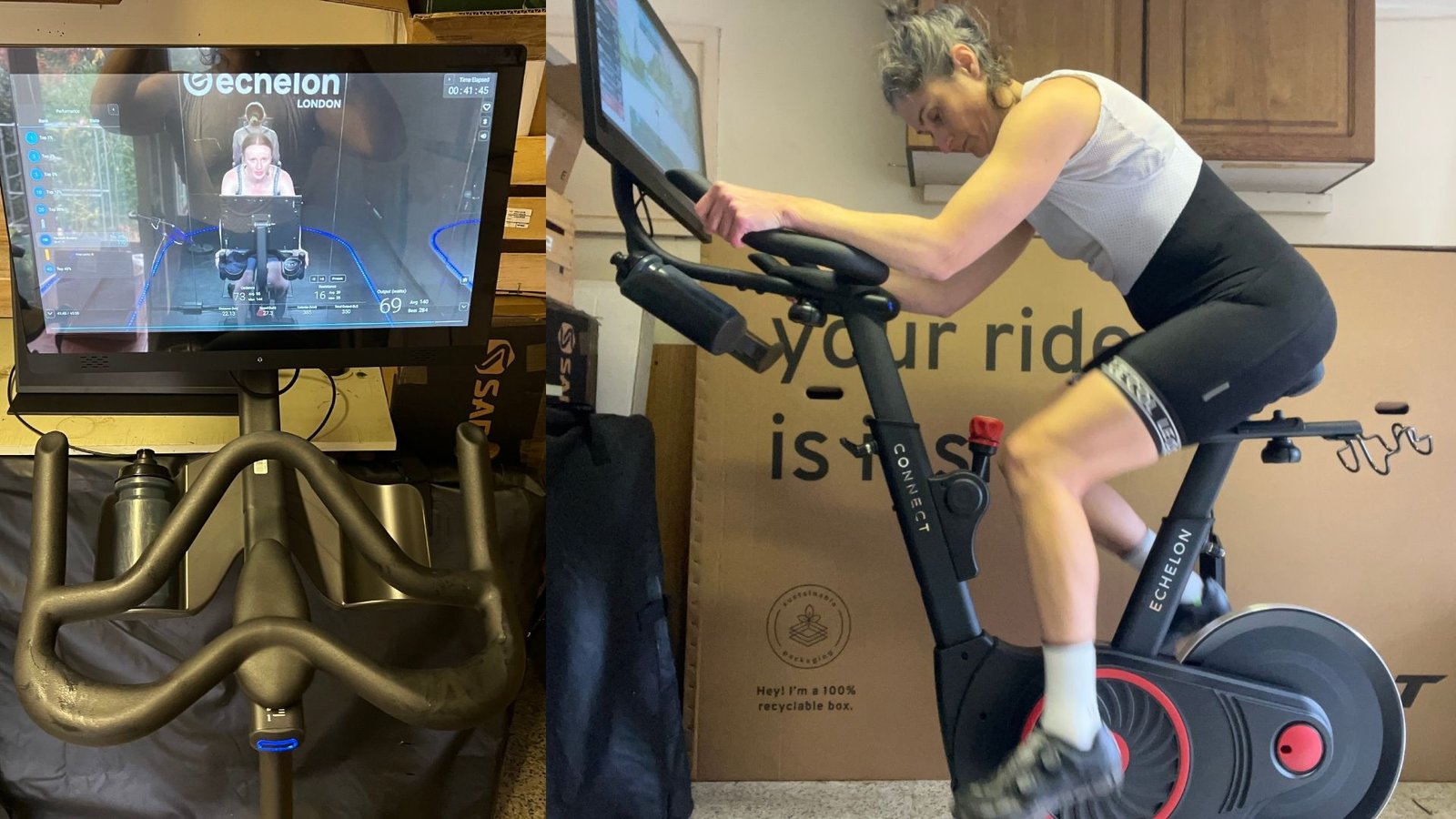
The biggest turnoff for me when it comes to indoor riding is the faff of setup. Even with the best indoor smart trainer and being fortunate enough to have a dedicated bike set up on the trainer for the whole of indoor season, it’s the digital aspect that sends me barmy.
My daughter’s tablet is the only piece of tech at home capable of running an online platform (thanks to work laptop firewalls and security settings), so between negotiating with her to use it, then the inevitable ‘software update’ that seems to haunt me for every session, I’m often in a bad mood before I’ve turned a pedal let alone even thought about what session Im going to ride.
Construction
When it comes to exercise bikes, there are several points of construction to consider, not only the bike’s design but also the software platform it uses. I’ve broken these features into chunks to make it easier to digest:
The Echelon EX-5s resistance adjustment knob
(Image credit: Future)
Construction:
The bike itself is primarily made from robust, heavy-duty, powder-coated welded steel. This prevents rust and corrosion from sweat and sports drinks; however, it also makes the Echelon EX-5s exceptionally heavy. In the box, it was stamped with a 60kg load, but once set up (more on that shortly), Echelon says it weighs around 56.5 kg / 124 lb, with 13 kilograms of the weight attributed to the flywheel at the rear of the bike.
The handlebars are made from the same powder-coated steel and feature a typical ‘spin bike’ design. This provides several hand position options, depending on your comfort with in and out of the saddle.
At the front of the bike is a plastic bottle holder mounted under the handlebars, capable of holding two bottles of any size thanks to its deep and long design.
At the rear is a metal, plastic-coated dumbbell rack. This is an optional extra for the Echelon EX-5s bike, allowing you to purchase the official weights or use your own; however, it limits weights to just 2 lbs / 1 kg.
Unlike the Peloton bike, the Echelon EX-5s does not have automatic resistance. Instead, this is controlled by the rider via a manual-indexed knob that adjusts the magnetic resistance on the flywheel between levels 1-32.
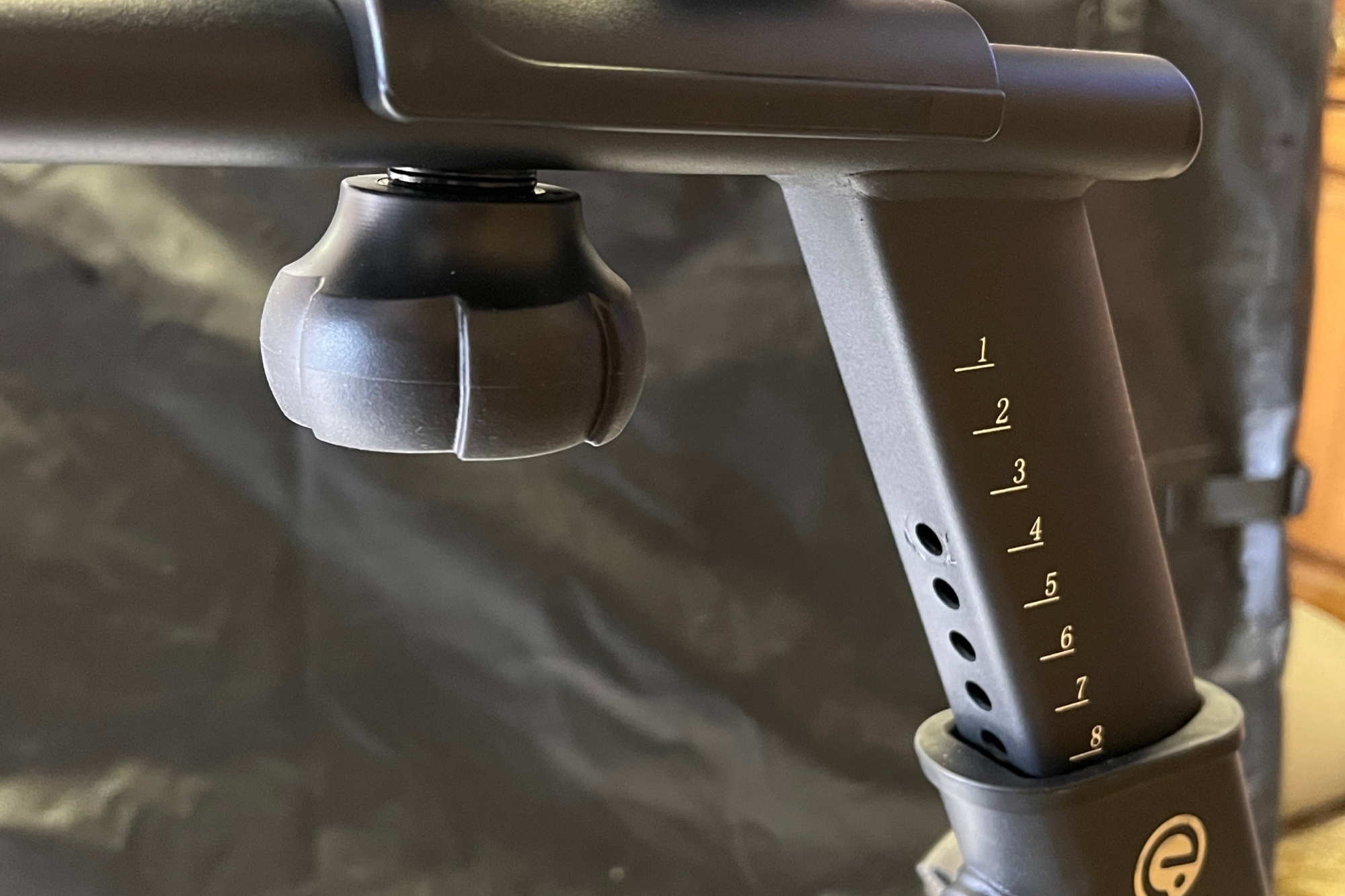
Saddle adjustment of the Echelon EX-5s
(Image credit: Hannah Bussey)
Out the box
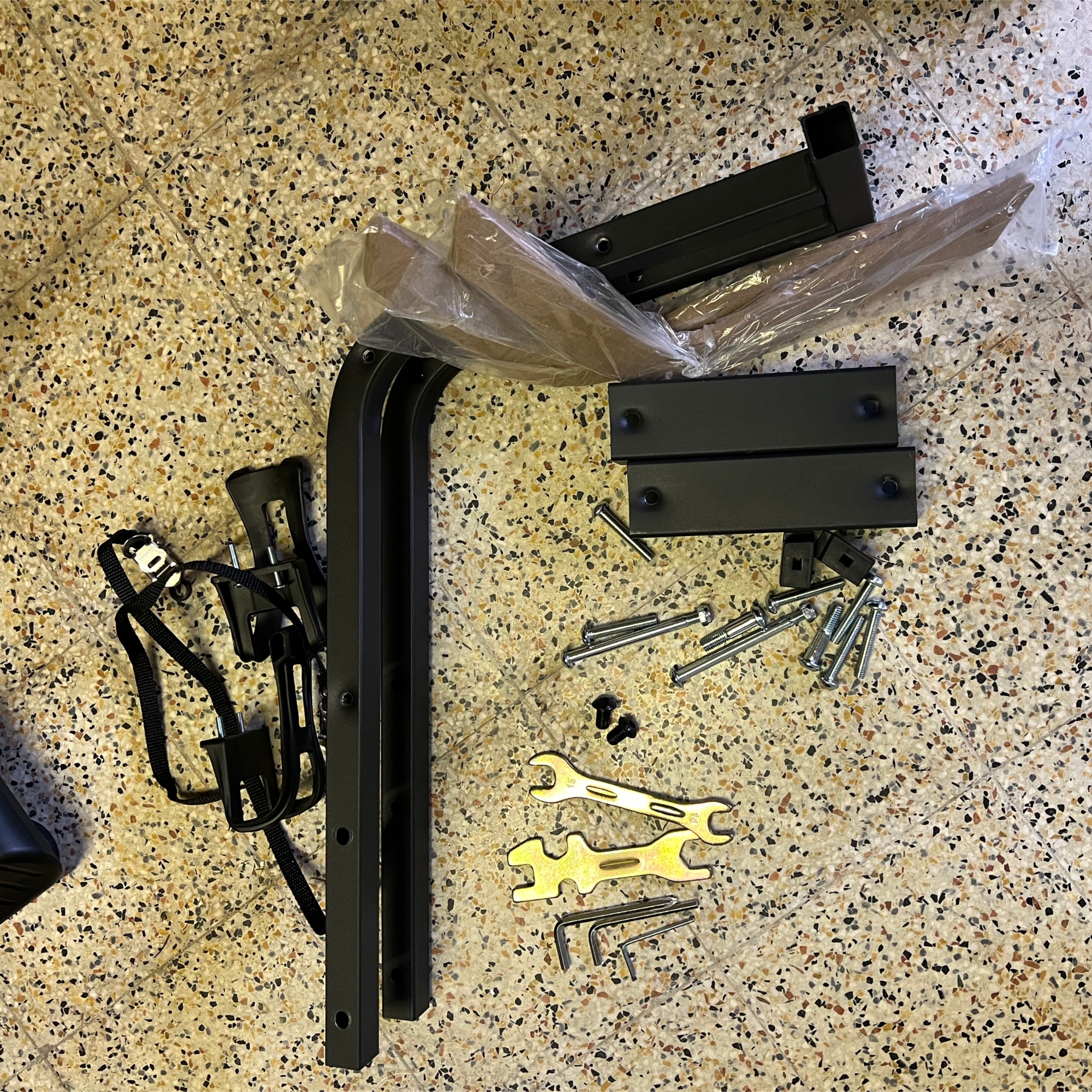
(Image credit: Hannah Bussey)
It would be remiss of me not to mention the assembly of the Echelon EX-5s. As I mentioned, the 60kg mass takes some shifting, and putting the bike together requires effort and shouldn’t be underestimated. I was shocked by how much additional steelwork, wood, nuts, and bolts go into the bike’s packaging, and the protective pieces still feel criminal to throw away.
I appreciate it’s better than having to dispose of a damaged bike. However, it was still shocking to see, especially when we transport much more valuable and vulnerable bikes with significantly less packaging. I suppose the hardware stops the heavy bike shifting around in the packaging, and harming whoever is shipping it, but it seems a waste to me. That aside, putting it all together is a manual job, and attaching the screen requires two people. While all the tools come with the bike, I wouldn’t underestimate the task. Unless you are mechanically minded, it’s best to subcontract to a family member or friend who is, or pay someone.
Measurements and limits
The overall footprint of the bike is approximately two meters long by at least 150 centimeters high. Width-wise, the support feet, which have large rubberised pads on the soles, span 50cm across. These measurements (specifically height and length) would be at the extreme as there is adjustability on the saddle and bar, but I would consider allowing for these numbers, before you buy, when planning a location at home for the Echelon EX-5s.
Your comfort on the bike can be refined by setting the four adjustment points just right. The saddle moves up/down by ten inches (17 adjustment settings) and forwards/backwards by four inches; and the handlebars: up/down by 6 inches and forwards/backwards by three inches. The screen is actually mounted on a spur of the bars, so it will move up and down with the bar height, but can be flipped over 180degrees when using for off-bike workouts.
According to Echelon, this should work for riders ranging between heights of 4’5″ – 6’8 to use and up to a weight of 136 kg / 300 lb.
Q Factor or, essentially, the gap between your legs when pedalling
The pedals attach to crank arms, to spin the flywheel on an exercise bike and this one is no different. They measure 170mm here which is pretty normal and comparable to a road bike. The Q factor, however, the distance between the outside faces of the crank arms, measures 204mm, which is considerably wider.
Road bikes pedals are typically around 160mm apart, a mountain bike, usually 170mm, with even a hybrid bike falling somewhere in between. This will mean a wider stance than you might be used to if you’re expecting this to feel like a regular outdoor bike.
When cross-referencing the Peloton bike, which, like a mountain bike, has a 170mm distance between the cranks, the Echelon EX-5s will feel much wider when pedalling.
Screen
The screen on the Echelon EX-5s is a large 21.5″ high definition touchscreen, which, once logged in, will enable the rider to access classes and workouts via a tap of the screen. If you are participating in an off bike workout, it neatly flips 180° to make it easy to see and use. However, again, another thing to bearing in mind when deciding where the bike should live at home.
Echelon digital platform
As with almost every exercise bike these days, the Echelon EX-5s has its own digital platform, Echelon Fit. It’s worth noting that, like any indoor bike, the EX-5s is intrinsically linked to the brand’s online world of classes and virtual riding, which usually comes at an extra, and usually monthly, cost.
Echelon says that it is possible to use the bike without committing to a subscription via the ‘Freestyle’ mode, but workout statistics and other information will not be stored.
If you want those features, membership prices vary depending on the length of your commitment, with the cheapest access option ranging from £19.99 / $TBC for two years upfront to £29.99 / $TBC for monthly payments.
This price includes more than just a spin class; it offers everything from live and recorded bike classes, yoga, meditation, and strength sessions to recorded images of famous mountain climbs, such as the Alpe d’Huez or Mont Ventoux. However, as mentioned above, none of the resistances are auto-adjusted.
There is also a newer FitOS platform, which enables access to a variety of online apps, such as entertainment (Netflix, Amazon Prime, YouTube, Spotify, etc), news, social media, and the Echelon World. This last app draws inspiration from platforms like Zwift, letting you race others in a VR world.
The benefit here is that it makes the Echelon EX-5s resemble a smart bike more closely, and the brand claims it will auto-adjust resistance when used with a programme that supports it. This feature is included free with the premium membership, and with up to five members on one plan, it could be an ideal option for a family.
The ride
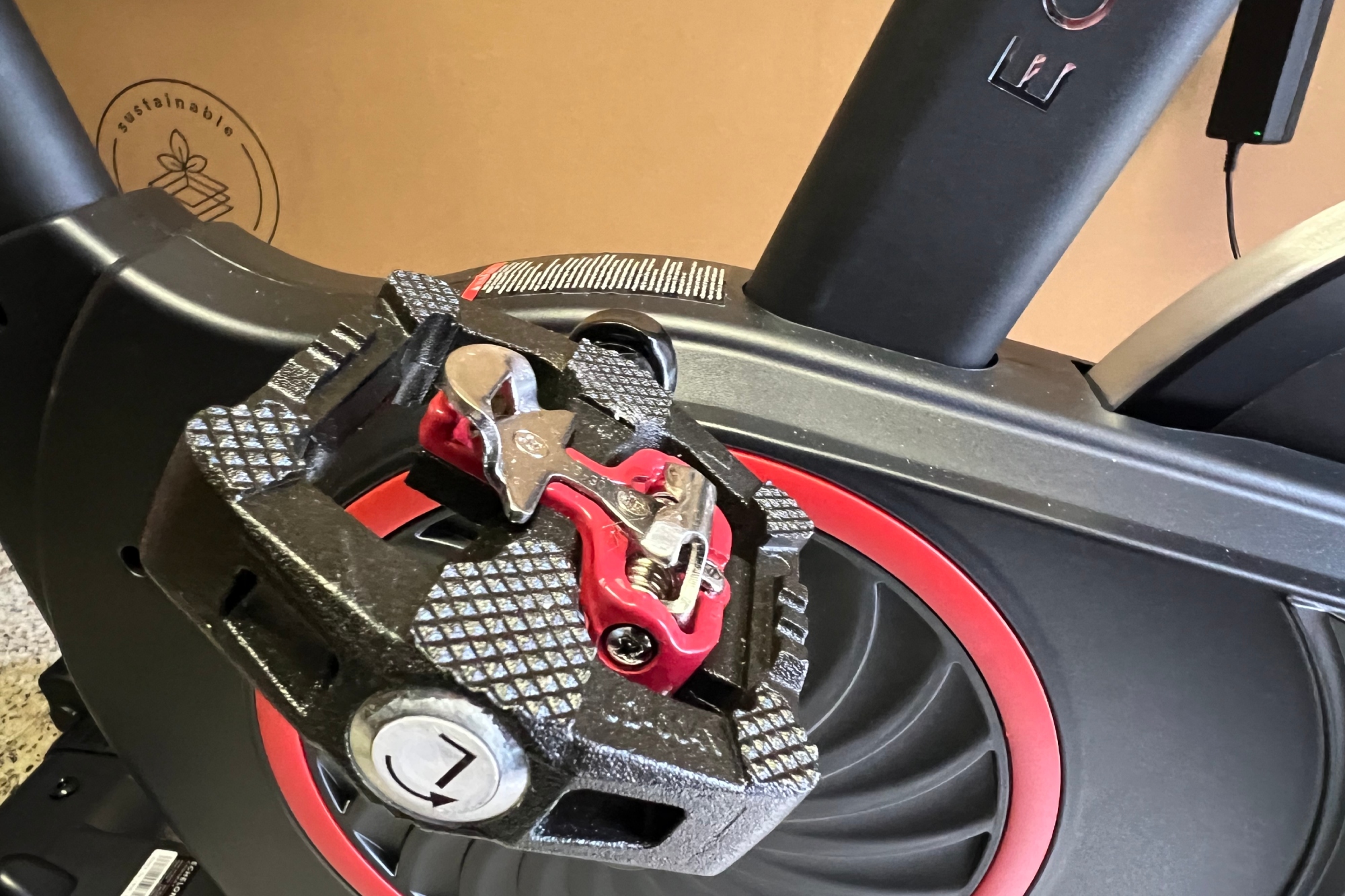
The Echelon EX-5s pedal is SPD compatible
(Image credit: Hannah Bussey)
Bike performance
The bike itself is solid. The large, tacky rubber pads under the wide feet do a really good job of securing the bike to the floor, even when you are out of the saddle or spinning at a fast cadence. I have the bike on a tiled floor and find it hasn’t traveled across the floor at all, which has happened to me with both a turbo trainer and rowing machine.
The overall riding position will be more comfortable for some than others. Having moved all adjustment points to replicate as close as possible my natural road riding position, I still find even with the saddle setback at full extension that my feet are forward of my hips, and the wide Q-factor is also noticeable, and slightly odd feeling. This should not bother you at all if you’re not used to riding on the road of course, but if you’re expecting that outdoor style experience or position, and are used to it, you will notice.
I’m comfortable enough with 45-minute maximum ride times, but wouldn’t want to use it for a long endurance ride, especially when clipped in. The saddle, like most exercise bikes, has been enlarged in volume and size. It’s not the worst saddle I’ve ever sat on, but I would prefer options of small, medium, or large when purchasing to improve longer ride comfort.
In theory, you could replace both the saddle and pedals with your own choices. The saddle rail mount is a curious design, and you’ll need to ensure compatibility with other options. However, changing the pedals is easier, which could help reduce the Q factor somewhat. The pedals work with Shimano‘s SPD style cleats, or you can use toe cages to secure your feet if you prefer that feeling, or just use them like flat pedals, with no foot retention.
Sharing the bike between riders is easy; just remember the adjustment setting number you prefer. I do have a slight ‘ick’ as these numbers don’t really relate to anything, coming in half-inch spacing, but it’s a minor thing once you know what it is. My only other gripe here is that the numbers for the Saddle height are all on the right-hand side, making it tricky to see if the bike’s home location is closer to the wall on that side, as mine is. Adding the decals to both sides really wouldn’t have blown the manufacturing budget.
When on and riding the machine, the bike feels very smooth. The red adjustment knob is easy to turn, and its bright colourway makes it visible in your peripheral vision, making it simple to reach for a resistance change.
There is a slight time lag of about a second between turning the knob and the resistance changing, but other than in over or under loading moments, while the electric magnetic resistance kicks in, it doesn’t really cause an impact.
For most riders, the 32 resistance levels will be enough. I was up towards the high twenties a couple of times during rides and could still pedal at around 60rpm. I suspect that if you’re a particularly strong rider, the hardest resistance will bottom out before you do, but it will still make you breathe hard and your legs sting, which is what really matters.
The issue becomes more noticeable when riding in FitOS World mode, where the resistance is automatically adjusted. I honestly thought it wasn’t functioning for a long time until I realised it was set so lightly, it barely felt active. I need to spend more time with the bike to figure out if I can adjust these settings, and I will also contact Echelon since this really undermines the feature.
It’s important to note that the Echelon EX-5s is a smart exercise bike, not a smart bike or home trainer. If you’re seeking an experience closest to outdoor riding, there are better options available. However, if you’re looking for a low-impact exercise that you can do at home, this bike is a great choice.
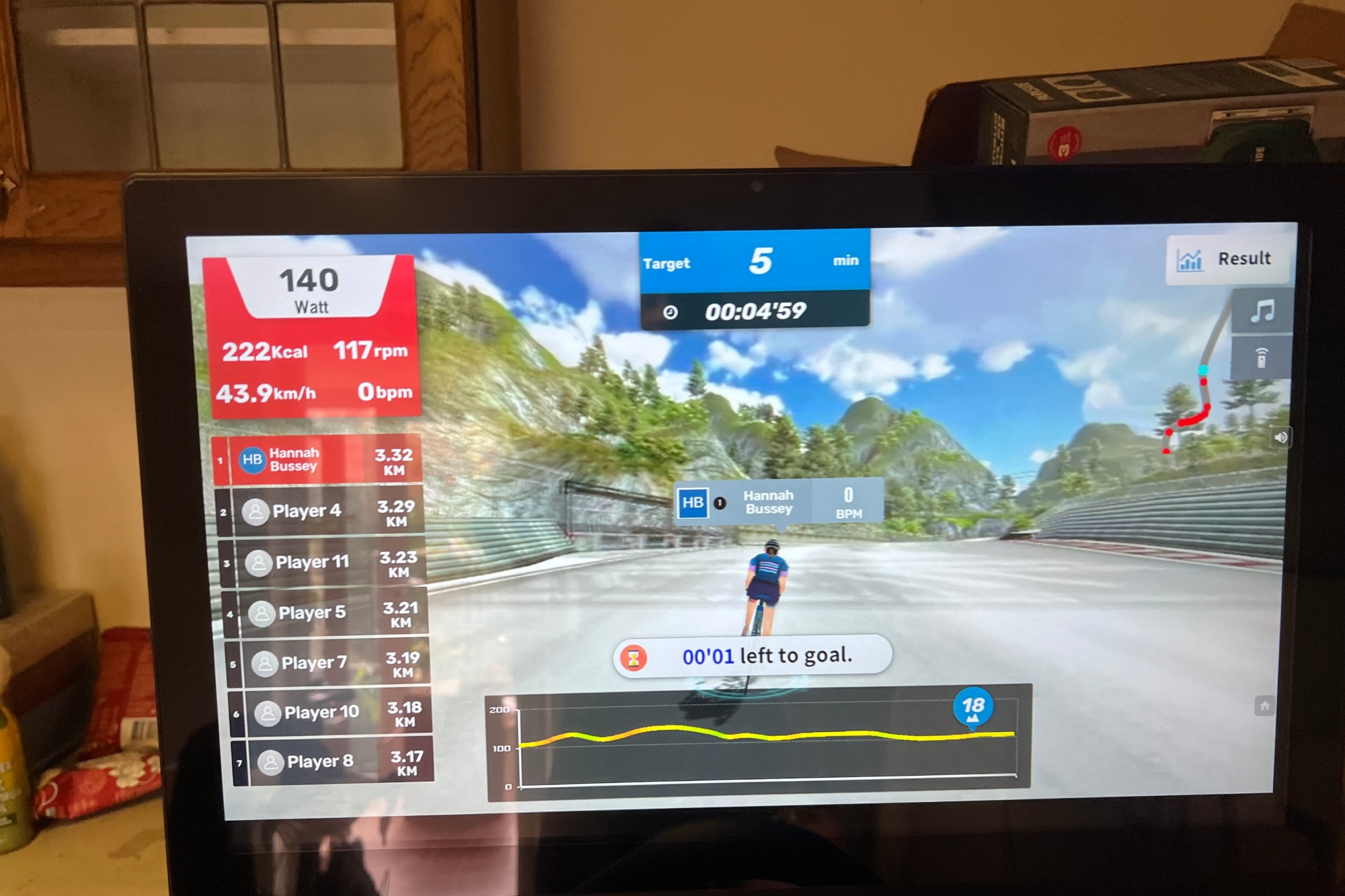
(Image credit: Hannah Bussey)
Echelon screen and digital platform performance
The digital interface is the key feature that distinguishes many exercise bikes. The screen on the Echelon EX-5s is incredibly clear and large enough for me to use without my glasses, something I struggle with on my phone or bike computer nowadays.
The screen responds to finger taps for menu selections, and the digital Echelon Fit platform responds swiftly, which makes a huge difference for me. Watching a spinning wheel on a computer is one of the most frustrating aspects of modern technology, and it drives me nuts that indoor cycling apps seem to do this every time you try to use them.
The only downside of the touchscreen is that, even after just a handful of rides, I can already see my fingerprints all over it. You’ll need to give it a wipe down after each workout, as is hygienic anyway. It wouldn’t have hurt for them to include something for that purpose.
So far, the Echelon has been responsive and often ready to ride before I am, which is incredibly refreshing and motivates me to keep coming back to this stress-free way of riding.
I’ve not used the bike for weeks on end yet, but so far I’ve worked my way through a good selection of recorded and live classes, which I’ve found fun, and even dabbled with the ride experience options.
The classes are the same format as a spin class: an instructor on the screen telling you what to do. The difference is that this time there’s no cheating. Your resistance level is shown at the bottom of the screen, along with cadence and power data; heart rate would also display here if you had a compatible monitor. The instructor indicates what resistance rating and cadence to hit throughout the class, and you’re encouraged to do it. Occasionally, I missed this instruction, but thankfully, I was never named and shamed.
Personally, I found the classes fun. They are kitsch and cheesy, much like real spin studios can be, but as long as you approach them with the right attitude, then you’ll also leave each workout in a good mood, having done some serious pedalling and worked up a good sweat.
There is a leaderboard slideout, which, according to Echelon, ‘calculates percentiles using averages from users who have completed similar workouts’, and it can give you a reference of where you stand with other Echelon riders. I find leaderboards a bit hit-or-miss for my motivation, depending on the direction of the numbers. So, when I was unimpressed with my riding performance, I just swiped it off the screen and just enjoyed the ride.
So far, I’ve paid zero attention to power data. I’ve found that I’ve been so focused on listening to resistance numbers and cadence in class that I’ve forgotten to even glance at the watts my legs are putting out.
The ride experience, which lets you choose to ride up a famous mountain or through an area like Tuscany, left me wanting more. It’s like riding with Google Street View vision, and without auto-resistance, you’re left to apply your own, with your cadence either moving you along faster or slower. Echelon needs to decide what it wants to do with this feature, as it feels like a letdown compared to classes . In my opinion, it would be better to remove it altogether until it can truly improve the ride features.
The other area that needs improvement is the Echelon FitOS World. It’s still early days for this part of the brand’s platform, and it has the potential to compete with some of the cycling app giants. However, it’s not quite there yet, so lower expectations if you’re hoping for a Zwift Wattopia style experience (for now).
Post rides, you can analyse your stats via the Echelon members portal, where you can get an overview of everything from a year to a day. Each session can be examined in detail, allowing you to see a breakdown of your workout statistics.
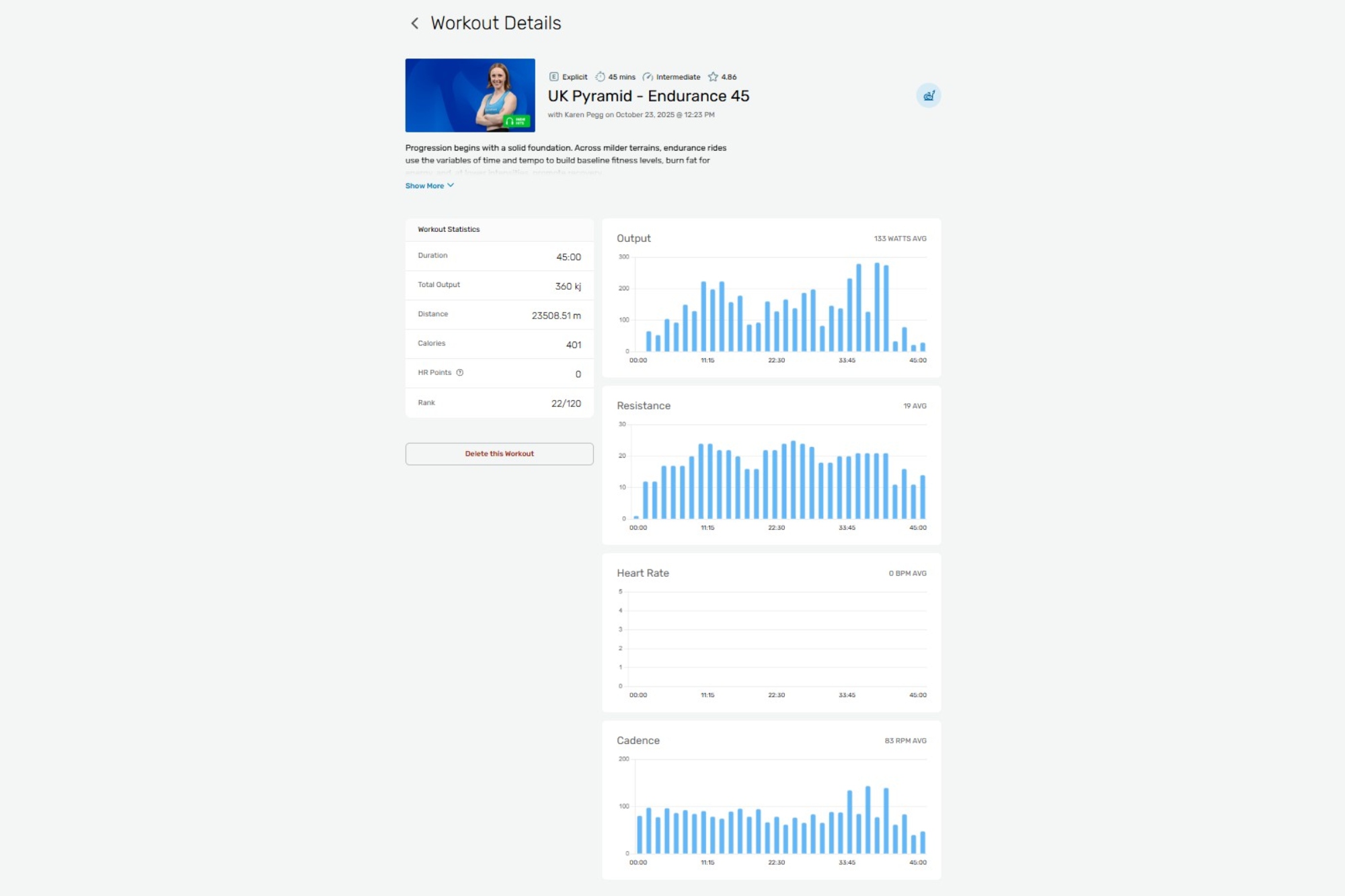
(Image credit: Hannah Bussey)
Value and conclusion
The Echelon EX-5s is more than just a Marmite bike of loving or loathing; some people, like me, will fall somewhere in the middle — really appreciating the added value it can bring into the home, but still seeing room for improvement.
Looking at alternatives on the market, the EX-5s can truly go toe-to-toe with the Peloton, and nothing else in the exercise bike market even comes close.
The positioning could use a slight adjustment; I’d like to see everything angled forward a bit more and the digital platform is nearing perfection, but isn’t quite there yet.
The resistance could benefit from some recalibration to prevent riders from spinning out, especially since being new to riding doesn’t mean you aren’t strong, particularly in the auto-adjust feature of FitOS Worlds.
Overall, this product is currently about 20% cheaper than Peloton for the bike itself. While the monthly membership costs are similar across the two brands, the Echelon membership covers up to five profiles, offering excellent value for money if your household takes full advantage.
Would I buy one? Probably not. Would I encourage my family members who don’t have confidence to ride outside or to have a gym membership? Absolutely yes.
Specifications
- Bike constructon – Powder-coated welded steel.
- Dimensions – 52″L x 20″W x 50″H
- Weight: 56.5 kg / 124 lb
- Flywheel: 13 kg rear placement
- Resistance: 1–32 levels manual magnetic resistance
- Max user weight: 136 kg / 300 lb
- User height range: 4’5″ – 6’8″
- Adjustability: Seat: 10” up/down, 4” forwards/backwards; Handlebars: 6″ up/down, 3″ forwards/backwards
- Display: 21.5″ HD touchscreen flips 180° for off-equipment workouts
- Pedals: SPD-compatible clips + Adjustable toe cages
- Extras: Rear-mounted dumbbell holders, two water bottle holders
Explore More
